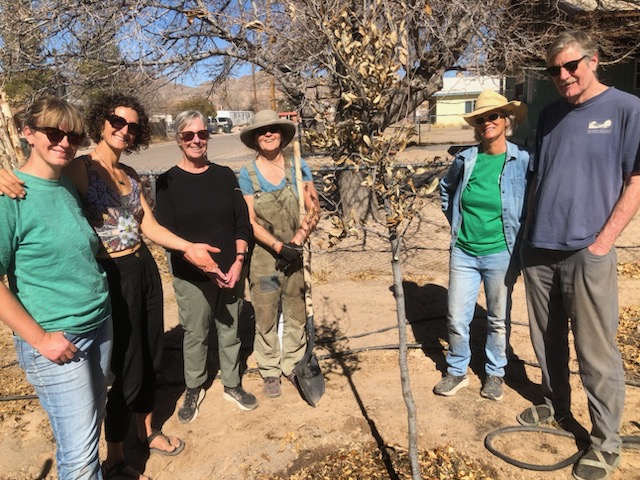Planting Trees in the High Desert of New Mexico
It is February. Seven of us gathered around a lifeless looking tree in a 15 gallon black pot, a southern live oak. Beside it is a hole twice its diameter dug in the ground. This is a Tree New Mexico (TNM) planting in the town of Williamsburg, in the middle of the Chihuahua Desert.
I witnessed this event at the invitation of June Russett who I interviewed for my book Our Journey to Sustainability. She had written a coloring book about composting. Now she was supervising tree plantings for TNM.
Ken, a volunteer learning how TNM does plantings, turns the potted tree on its side while others carefully remove it from the pot, and set in the hole. A rake handle is placed across the hole to make sure that the root ball is not too shallow and not too deep. Then Melinda, who owns the residence, carefully pulls at the roots, making sure that none had wrapped around the bottom of the pot.
This is one of 60 plantings to be done this month by volunteers in and near Truth or Consequences, New Mexico. In a couple weeks 66 additional trees in 5 gallon pots will be given to homeowners. Each tree came from a nursery in Las Cruces, 70 miles to the south. Besides southern live oak, we will have honey mesquite, desert willow, vitex, lace bark elm, and Afghan pine. Each species has been chosen to be “climate ready” for the high desert in southwest New Mexico.
Sand is shoveled into the hole under and around the root ball. Not fertilizer. We want the tree to get used to the native soil and reach its roots beyond the circle we’ve dug. Water is added to both the root ball and the sand. This forms a thick slurry that will bond the tree to the earth – a process called mudding. Compost is added on top of the sand. You wiggle the youthful trunk to remove air pockets. All is thoroughly wetted down. We don’t want dry compost to wick water up from below.
I ask, if these trees are native. “No.” I’m told the purpose of these plantings is to “decrease the urban heat index”. These trees are an antidote to the urban heat island effect. This planting is a TNM’s local hands-on mitigation for our human presence. In the language of the UN’s Intergovernmental Panel on Climate Change, our modest effort could be considered afforestation, “the process of establishing a forest or stand of trees in an area where there was no forest or woodland before.”
We gather for a group photo. New leaves will be appearing in a month or so. It will be up to Malinda to see that the tree is watered every two weeks or so for about three years. If all goes well, the oak will thrive for 250 to 500 years, a legacy each of us can share.
This is the second round of such plantings. Last fall 53 volunteers, including the mayor of Truth or Consequences, planted 49 trees. Another 61 trees were given to homeowners in Sierra County. Our planting is part of a TNM statewide outreach.
Thanks to TNM and its program ABQ NeighborWoods, Albuquerque’s tree canopy increased by over 8500 trees since 2017 – with an 84 percent survival rate.
TNM’s Tree Stewards program provides a 12-week deep dive into understanding trees, volunteering, and urban forestry. The program requires that, “You must be willing to learn from and partner with other tree advocates in your community, especially those who are largely responsible for the community’s trees.”
Sue Probart founded Tree New Mexico in 1990 with high school students and friends. She also served on the New Mexico Tree Planting Advisory Committee and the New Mexico Urban Forest Council. A memorial tree planting was held in Sue’s honor in 2023.
Sadly, this may be the last TNW planting in the area for a while. June tells us that grant funding from the Inflation Reduction Act is being halted by the new Administration in Washington.
Jon Biemer is the author of Our Journey to Sustainability: How Everyday Heroes Make a Difference (2024) and Our Environmental Handprints: Recover the Land, Reverse Global Warming, Reclaim the Future. Jon is a professional mechanical engineer, registered in California, and a member of the Society of Environmental Journalists.

